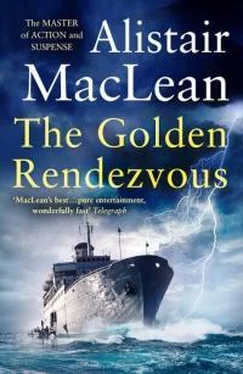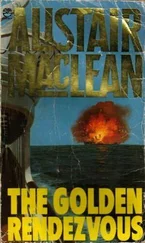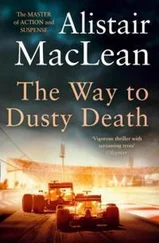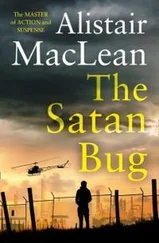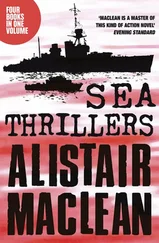He closed the door, locked it and went down the ladder to “A” deck below. I followed him to the top of the ladder and stayed there. There was another man at the foot of the ladder, lit torch in hand, just outside Dr. Caroline’s cabin, and in the backwash of light from the cabin bulkhead I could see who it was. Carreras himself. There were two other men close by, and I could distinguish neither of them, but I was certain that one of them would be Dr. Caroline. They were joined by the radio operator and the four men moved off aft. I never even thought of going after them. I knew where they were going.
Ten minutes. That was the detail the news broadcast about the disappearance of the Twister had mentioned. There were only one or two men who could arm the Twister, and it couldn’t be done in less than ten minutes. I wondered vaguely if Caroline knew he had only ten minutes to live. And that was all the time I had to do what I had to do. It wasn’t long.
I was coming down the ladder while Carreras’s swinging torch was still in sight. Three-quarters of the way down, three steps from the bottom, I froze into immobility. Two men – in that driving rain their black blurred shapes were barely distinguishable but I knew it was two men because of the low murmur of voices – were approaching the foot of the ladder. Armed men, they were bound to be armed, almost certainly with the ubiquitous tommy-gun which seemed the standard weapon among the generalissimo’s henchmen.
They were at the foot of the ladder now, I could feel the ache in my hands from the tension of my grip round marline-spike and opened clasp-knife, then suddenly they went veering off to the right, round the side of the ladder. I could have reached out and touched them both, I could see them almost clearly now, clearly enough to see that both had beards, and had I not been wearing the black hood and mask they would have been bound to see the white glimmer of my face. How they didn’t even see my shape standing there on the third bottom step was beyond me: the only reason I could think of was that they both had their heads lowered against the driving rain.
Seconds later I was inside the central passageway of “A” accommodation. I hadn’t poked my head round the outside passage door to see if the land was clear, after that escape I’d felt that nothing mattered, I’d just walked straight inside. The passageway was empty.
The first door on the right, the one opposite Caroline’s, was the entrance to Carreras’s suite. I tried the door. Locked. I walked down the passage to where Benson, the dead chief steward, had had his cubicle, hoping that the luxurious carpet underfoot was absorbent enough to soak up the water that was almost cascading off me. White, Benson’s successor, would have had a blue fit if he could have seen the damage I was doing.
The master-key to the passengers’ suites was in its secret little cubby-hole. I removed it, went back to Carreras’s cabin, unlocked the door and went inside, locking it behind me.
The lights were on throughout the suite. Carreras probably hadn’t bothered to switch them off when he’d left, he wasn’t paying for the electricity. I went through the cabins, sending each door in turn flying open with the sole of my stockinged foot. Nothing? No one. I had one bad moment when I entered Carreras’s own sleeping cabin and saw this desperate hooded, crouched figure, dripping water, hands clenched round weapons, with wide staring eyes and blood dripping down beside the left eye. Myself in a looking-glass. I had seen prettier sights. I hadn’t been aware that I had been cut, I supposed it must have been the result of one of the many knocks I’d had had against the side of the Campari , opening up the wound in my head.
Carreras had boasted that he had a complete loading plan of the Fort Ticonderoga in his cabin. Nine minutes now, maybe even less. Where in the name of God would he keep the plan? I went through the dressing-tables, wardrobes, lockers, cupboards, bedside tables. Nothing. Nothing. Seven minutes.
Where, where would he keep it? Think, Carter, for heaven’s sake think . Maybe Caroline was getting on with the arming of the Twister faster than anyone had thought possible. How did anyone know, as the broadcast had said, that it took all of ten minutes to arm it? If the Twister was such a secret – and until it had been stolen it had been such a top priority hush-hush secret that no member of the public had known of its existence – how did anyone know it took ten minutes to arm it? How could anyone know? Maybe all it required was a twist here, a turn there. Maybe – maybe he was finished already. Maybe – –
I put those thoughts to one side, drove them out of my mind, crushed them ruthlessly. That way lay panic and defeat. I stood stock-still and forced myself to think, calmly, dispassionately. I had been looking in all the obvious places. But should I have been looking in the obvious places? After all I’d gone through this cabin once before, looking for a radio, I’d gone through it pretty thoroughly, and I hadn’t seen any signs. He would have it hidden, of course he would have it hidden. He wouldn’t have taken a chance on anyone finding it, such as the steward whose daily duty it was to clean out his cabin, before his men had taken over the ship. No stewards on duty now, of course, but then he probably hadn’t bothered to shift it since the take-over. Where would he have hidden it where a steward wouldn’t stumble across it?
That ruled out all the furniture fittings, all the places I’d wasted time in searching. It also ruled out bed, blankets, mattresses – but not the carpet! The ideal hiding-place for a sheet of paper.
I almost threw myself at the carpet in his sleeping cabin. The carpets in the Campari’s accommodation were secured by press-button studs for ease of quick removal. I caught the corner of the carpet by the door, ripped free a dozen studs, and there it was right away, six inches from the edge. A large sheet of canvas paper, folded in four, with “T.E.S. Fort Ticonderoga . Most Secret” printed in one corner. Five minutes to go.
I stared at the paper until I had memorised its exact position relative to the carpet, picked it up and smoothed it out. Diagrams of the Ticonderoga with complete stowage plans of the cargo. But all I was interested in was the deck cargo. The plan showed crates stacked on both fore- and aft-decks, and twenty of those on the foredeck were marked with a heavy red cross. Red for gold.
In a small careful hand Carreras had written on the side: “All deck cargo crates identical in size. Gold in waterproof, kapok-filled welded steel boxes to float free in event of damage or sinking. Each crate equipped with yellow water-stain.” I supposed this was some chemical which, when it came into contact with salt water, would stain the sea for a wide area around. I read on: “Gold crates indistinguishable from general cargo. All crates stamped ‘Harmsworth & Holden Electrical Engineering Company.’ Stated contents generators and turbines. For’ard deck cargo consigned to Nashville Tennessee, exclusively turbines: afterdeck cargo consigned to Oak Ridge Tennessee, exclusively generators. So marked. For’ard twenty crates on for’ard deck gold.”
I didn’t hurry. Time was desperately short, but I didn’t hurry. I studied the plan, which corresponded exactly to Carreras’s observations, and I studied the observations themselves until I knew I would never forget a word of them. I folded and replaced the plan exactly as I had found it, pressed the carpet snap-studs back into place, went swiftly through the cabins on a last check to ensure that I had left no trace on my passing: there were none that I could see. I locked the door and left.
Читать дальше
Конец ознакомительного отрывка
Купить книгу
